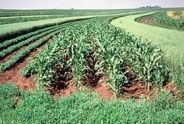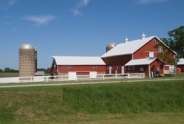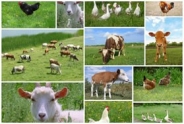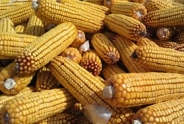Spreading Dogbane - A problematic weed in SWNY
Joshua Putman, Field Crops and Forage Specialist
Southwest New York Dairy, Livestock and Field Crops Program
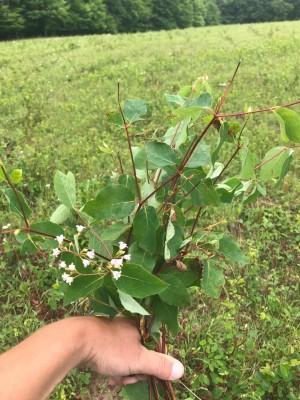
Josh Putman, Field Crops Specialist with the SWNY Dairy, Livestock & Field Crops program recently ran across a plant in a hay field that had not been worked for a few years and was very difficult to identify. Pictures of the weed were sent to Cornell's Weed Ecology and Management Laboratory and correctly identified. Spreading dogbane, Apocynum androsaemifolium, is in the same family as milkweeds and swallowworts, and the same genus as hemp dogbane. This perennial plant is found in open, dry areas and in disturbed habitats throughout New York and most of the US and Canada.
Leaves: Leaves are oval, 4-6cm (around two inches long), with smooth edges and pinnate veination. They are arranged opposite each other on the branch.
Mature Plant: 0.6m (2 feet) tall, although some sources say 2-5′, with branching reddish stems. Flowers are found at the ends of branches.
Flowers/Fruit: Flowers are bell-shaped with 5 petals that are fused to form the bell and then curl outwards. Flowers can be white as were seen in western NY, but can also be pink or white with pink striping. Fruit are a long, narrow pod up to 11cm (over 4 inches) long; each flower produces two seed pods. Inside the pods are many small seeds with fluffy tufts, much like milkweed or swallowwort seeds.
Toxicity: Dogbanes are reported to be toxic to livestock, containing a compound that interferes with heart function. This toxicity persists when the plant is dried as well as when fresh. There is no specific information on the toxicity of this species to livestock.
Management: Management for this species in agricultural settings was sparse; most resources discussed it in the context of a native wildflower/shrub. In blueberry fields, nicosulfuron mixed with surfactant suppressed spreading dogbane (>60%), and dicamba spot sprays were over 80% effective. Glyphosate spot sprays worked better than hand pulling, and wiping with glyphosate was also effective (Wu and Boyd, 2012). In and early experiment from the 1940s, dogbane was partially suceptible to 2,4 D (Egler 1947). In a forest setting, aerial application of glyphosate did not control spreading dogbane (Pitt et al 2000). An article from 1947 looking at impacts of 2,4D on vegetation in CT says for spreading dogbane "partially susceptible in early spring. A .50 % solution in mid-June proved effective. A second spraying for new shoots from underground roots may be necessary." A follow up study said 2,4 D mixed with 2,4,5 T was even better, with no regrowth, but I don't know if that's a current pesticide or not. It was not removed by an aerial spray of glyphosate from jack pine plantations in a 2000 paper.
References
New York Flora Atlas: http://newyork.plantatlas.usf.edu/Plant.aspx?id=123
Native Plant Trust's Go Botany online plant key: https://gobotany.nativeplanttrust.org/species/apocynum/androsaemifolium/?pile=non-alternate-remaining-non-monocots
USDA Plants Database: spreading dogbane page. https://plants.usda.gov/core/profile?symbol=APAN2.
University of Maryland Extension Toxic Plant Profile: Milkweed and Dogbane: https://extension.umd.edu/learn/toxic-plant-profile-milkweed-and-dogbane
Ohio State University Perennial and Biennial Weed Guide: Hemp Dogbane. https://www.oardc.ohio-state.edu/weedguide/single_weed.php?id=40
Fire Effects Information Systems entry for spreading dogbane: https://www.fs.fed.us/database/feis/plants/forb/apoand/all.html#125 .
Lin Wu and Nathan S. Boyd. 2012. Management of Spreading Dogbane (Apocynum androsaemifolium) in Wild Blueberry Fields. Weed Technology 26(4)777-782.
Frank E. Egler. 1947. 2,4-D Effects in Connecticut Vegetation, Ecology 29(3)382-386.
Frank E. Egler. 1949. Herbicide Effects in Connecticut Vegetation, Ecology 30(2) 113-270.
Douglas G. Pitt et al. 2000. Five Years of Vegetation Succession Following Vegetation Management Treatments in a Jack Pine Ecosystem. Northern Journal of Applied Forestry 17(3) 100-109.
Upcoming Events
Memoir Reading: Barn Gothic
December 4, 2025
Bath, NY
Barn Gothic is an elegy for family farmers and an intimate portrait of three generations laboring to be fathers and sons while their livelihood falls apart. Beautifully told with a farmer's restraint and a poet's grace, it is a story of personal loss amid corporate corruption and of finding a way forward when everything you know disappears.
NY Small Farms Summit 2025: Stronger Together
December 5, 2025
Alfred, NY
We hope you will join us on December 5th for the 2025 New York Small Farms Summit! This is an opportunity to meet other farmers and ag supporters, learn about research and education projects, and set priorities for future efforts to grow small farm success.
At the Allegany County site, we will focus on giving trees a chance and how trees build resiliency on small farms. Whether attracted to fruit, nuts, vegetables, fodder or shade, trees can be an integral part of a successful farming system. Join us as we explore the opportunities for resiliency that come from adding tree crops or managing wooded areas of your farm for agroforestry or silvopasture systems.
Crops, Cows & Critters - Southwest New York Dairy, Livestock & Field Crops Newsletter Sponsorship
December 19, 2025
Our two forms of publications feature research-based and timely information from our four specialists, listed to the right, along with local event notifications and Cornell University outreach. This information is provided to participants who range from dairy, livestock, and field crops producers to agricultural suppliers and consultants.
Weekly Email Update: Shared with 625+ households who have signed up with our program.
Monthly Paper Mailer: To reach our stakeholders and farmers who lack internet access, we send out a monthly mailer where your company's logo and contact information would be featured with a mailing list of 330+ households.
If you sponsor our weekly and monthly publications you reach approximately 955 households.
Visit our website to view our newsletters!
Announcements
No announcements at this time.

